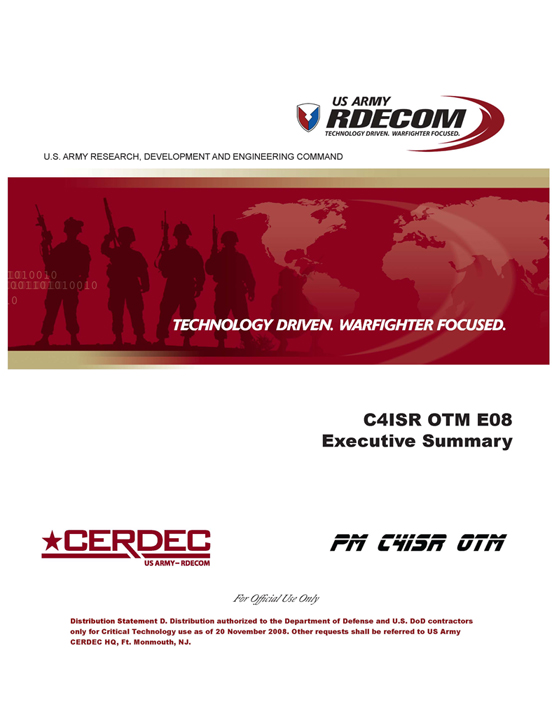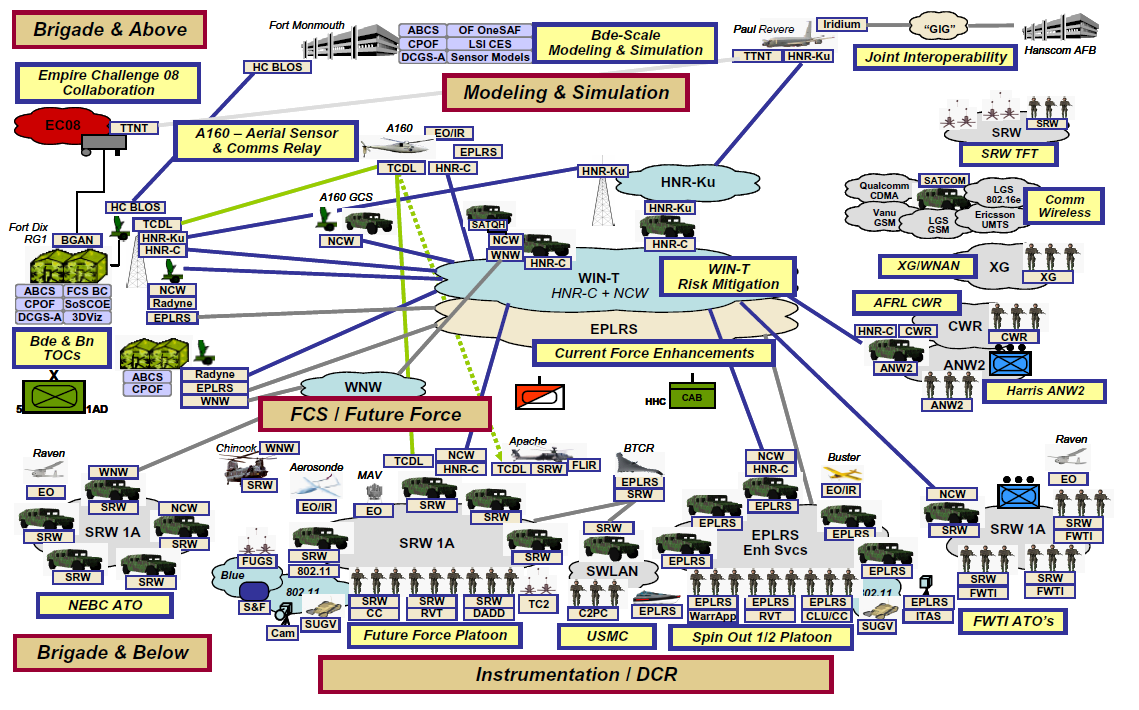 U.S. RDECOM
U.S. RDECOM
- Distribution Statement D. Distribution authorized to the Department of Defense and U.S. DoD contractors only for Critical Technology use as of 20 November 2008. Other requests shall be referred to US Army CERDEC HQ, Ft. Monmouth, NJ.
- For Official Use Only
- 15 pages
- November 20, 2008
Product Manager Command, Control, Communications, Computers, Intelligence, Surveillance, Reconnaissance (C4ISR) On-The-Move (PM C4ISR OTM), is a Research, Development and Engineering Command (RDECOM) Communications-Electronics Research, Development and Engineering Center (CERDEC) organization, chartered in June 2006 to perform integrated C4ISR System of Systems (SoS) Live/Virtual/Constructive (L/V/C) technology demonstrations on a year-round basis. PM C4ISR OTM facilities include a relevant field environment at Fort Dix, NJ and development, integration and simulation laboratories that leverage High Performance Computing (HPC) capabilities at Fort Monmouth, NJ. As an Army capital investment, PM C4ISR OTM supports both Department of Defense and industry technology development efforts by providing a “test/assess-analyze-fix” environment in which systems supporting Future Force initiatives or being considered for acceleration into the Current Force, can be matured and evaluated in a relevant, structured, low-risk manner. Activities conducted at PM C4ISR OTM’s lab or field sites are not formal “tests”, but are activities constructed as opportunities to expose systems to conditions not ordinarily available within their development environments. The goal of these activities is to evaluate systems against specific performance criteria, and then facilitate maturation by providing early feedback to the developing organization.
From April through August of 2008, RDECOM, CERDEC, and PM C4ISR On-The-Move executed the largest C4ISR and Networking Technology Demonstration to date, referred to as C4ISR On-The-Move Event 08 (E08). Utilizing the combined capabilities of the Joint Megabase (Fort Dix, Lakehurst Naval Air Engineering Station, McGuire Air Force Base), E08 built upon the accomplishments of E07, both in the number of systems and in the complexity of their interconnections. The demonstration enabled a network-centric environment, incorporating more than 100 live communications, sensor and battle command systems. These live systems were complemented by a Brigade-sized element represented in virtual and constructive simulation utilizing organic HPC assets, and instrumented via a robust suite of automated data collection tools.
E08 was designed to assess the technical capability, functionality, maturity, and performance of future, emerging, and Spin Out technologies, and was comprised of Axes of Exploration, Collaborative Efforts, and Technology Excursions.
Key issues relevant to the Army’s transformation effort were organized into five diverse, dependent Axes of Exploration termed Brigade and Above, Brigade and Below, FCS/ Future Force, Modeling and Simulation, and Instrumentation, Data Collection and Reduction. Each Axis of Exploration differed in focus, but all utilized a common integrated C4ISR SoS architecture. Each Axis addressed requirements from various customer organizations, but all were aligned to facilitate overall event execution and designed to support broader Army and DoD requirements. For each Axis, individual systems were evaluated in component-level assessments. Communication, sensor and battle command systems were then integrated into a SoS for end-to-end technical evaluations. Finally, force effectiveness was studied by conducting missions designed to assess technology in a relevant environment. Customized automated data collection and reduction tools developed by the PM and leveraged from Army and DoD partners were employed, which allowed comprehensive evaluation and assessment of both individual system and emerging SoS metrics.…
The E08 Technology Demonstration builds upon the accomplishments of C4ISR OTM E07, both in the number of systems and in the complexity of their interconnection. This is reflected in the overall E08 architecture, which included both live and simulated components, and enabled the exploration of key communications, sensor and battle command questions, in order to assess the technical capability, functionality, maturity, and performance of future, emerging, and Spin Out technologies. Key issues relevant to the Army’s transformation effort were organized into five diverse, dependent Axes of Exploration termed Brigade and Above, Brigade and Below, FCS/ Future Force, Modeling and Simulation, and Instrumentation, Data Collection and Reduction, as illustrated in the figure below:
The Brigade & Above Axis focused on issues associated with the upper echelons of Brigade Combat Team structures and their relationship to above-Brigade and Joint warfighting elements. Elements of WIN-T Increment 2 and Increment 3 architectures were juxtaposed with CDL systems in ground and airborne configurations. Assessments were designed that directly tied into programmatic requirements and also explored architectural options. A variety of Joint intelligence and sensor exchanges were demonstrated and several technical evaluations of ISR and Battle Command interoperability were conducted. Key activities included:
- Mitigating risk for PM WIN-T Increment 2 & 3 test events;
- Exploring the relationship between the WIN-T/JTRS and CDL architectures;
- Assessing the impact of Joint ISR and Sensor Fusion on tactical operations;
- Evaluating the degree of interoperability and collaboration between ISR and Battle ♦♦Command systems across the Current & Future Forces.
The Brigade & Below Axis focused on issues associated with Company and Platoon-level units, explored through scripted technical evaluations and through the execution of a series of tactical missions conducted with Soldier role players. Both Future Force and Current Force communications systems were employed for voice and data transport, and a variety of air and ground-based sensor systems facilitated the collection of information on Threat forces. The integrated architecture that supported the Soldier-in-the-loop assessments effectively linked a Future Force network (JTRS/SRW) with a Current Force network (EPLRS) via a WIN-T Increment 2 backbone. This network-of-networks enabled the transmission of voice, video and application traffic representative of Future Force data exchanges. Additionally, several communications systems not currently within the formal DoD Acquisition cycle were demonstrated and evaluated. Key activities included:
- Mitigating risk for JTRS HMS/NED test events;
- Investigating methods of augmenting Current & Spin Out 1/2 Force elements in order to increase information dissemination & collaboration;
- Evaluating the utility of lower echelon ISR systems, with emphasis on common control and receive mechanisms;
- Exploring alternative lower echelon communications architectures.
The FCS / Future Force Axis leveraged elements of the Brigade & Below Axis as well as additional systems and assessments conducted by PM FCS (BCT) Network Systems Integration (NSI), which continued after the completion of E08. The goal of these complementary efforts was to begin to understand the scalability of the end-to-end FCS architecture by combining actual FCS software and hardware systems across the Live, Virtual and Constructive space. Key activities included:
- Mitigating technical risk for the FCS program;
- Quantifying the cognitive impact that variations of the FCS SoS have upon warfighters during the execution of tactical tasks;
- Assessing the capability and maturity of emerging FCS hardware and software systems.
The Modeling & Simulation Axis provided support to the first three Axes, as well as conducting focused assessments of emerging software modeling and simulation approaches utilizing both HPC and non-HPC assets. The live component of the C4ISR OTM E08 architecture was stimulated by a Brigade-sized simulation, Objective Force OneSAF running on an HPC platform, and included both maneuver and sensor elements. Traffic profiles derived from tactical network data collected from local, national, and in-theater sources were used to load selected links. Individual studies were also conducted with the goal of comparing the measured performance of live C4ISR systems with software models intended to represent their behavior.

